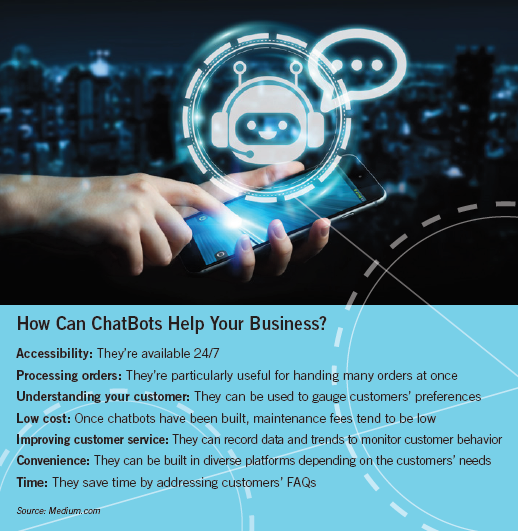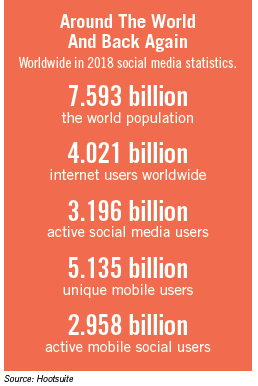Fast Forward: Let's Chat About Chatbots

Tech Talk
Let’s Chat About Chatbots
Companies are using chatbots to improve customer service, cut costs and save time.
Self-proclaimed business magnet Elon Musk, the founder and CEO of SolarCity, Tesla and SpaceX, is known for his predictions about the burgeoning growth of artificial intelligence (AI). With AI anticipated to continue its rapid expansion, the promotional products industry can benefit from related technologies. One of the more common AI technologies used across all industries is that for chatbots.
What is a chatbot?
A chatbot is a program that allows computers to engage in natural, human-like conversations with people via an instant messaging system. This program can be tailored to immediately respond to customers’ messages with an automatic response or a custom response, depending on the contents of the message.
Before you question the logistics behind this, recall that time you browsed a few websites in search of a winter jacket. It’s likely that on at least one website, a customer service “rep” messaged you asking, “How can we help your shopping experience today?” You may or may not have used the tool, but this friendly rep was actually a chatbot. You might also encounter chatbots when using mobile banking tools or when being asked to provide feedback about a product or experience. It’s a technology that has made ecommerce faster and easier, and it’s one that all major corporations are using, from Marvel, StubHub and Miller Light to CNN, Expedia and Bank of America.
 How can chatbots help your business?
How can chatbots help your business?
Chatbots can offer a seamless customer service experience. They enable businesses to follow-up with customers after transactions have been completed, while incorporating personality that is unique to the brand. According to Chatbots Magazine, people prefer chatbots over phone calls, and over downloading phone applications that are specific to each business or service (The Amazon App, the UberEats app, Chase Mobile Banking app, etc.), which take up precious storage space.
Companies like Disney, Pizza Hut and Whole Foods have demonstrated ways that chatbots can be used to engage customers. Pizza Hut took the “traditional” approach, using a chatbot to take customers’ orders, respond to their inquiries about menu items and share promotional information. Disney took a different approach, designing a chatbot named Officer Judy to promote the release of its 2016 movie Zootopia. Using Facebook Messenger—which is used by more than 100,000 chatbots, according to Chatbots Magazine—Officer Judy chatted with customers for up to 10 minutes, who “helped” her solve cases. Whole Foods, on the other hand, offers a chatbot where customers can use Facebook Messenger to connect with recipes. By simply typing in a single emoji or a set of emojis—like an apple and a donut—the chatbot will respond with recipes that involve these foods, like an apple pastry.
One of the most pressing debates about AI and chatbots is the technology could replace human labor, and indeed it can, but certainly not all purposes. According to Medium, computers will only complement human labor—not replace it. But companies looking to downsize or automate some of their existing systems can use chatbots to replace certain responsibilities, specifically tedious tasks, like managing customer service requests and data, addressing complaints and completing orders in a timely manner. If needed, these employees’ skills could then be redirected to developing other areas of the business that merit focus. This information is also aligned with the findings of Gartner, which reported that 85 percent of customer interactions will be computerized by 2020, and Servion Global Solutions, a contact center consulting service that reported this number will reach 95 percent by 2025.
Businesses also use chatbots because chatbots drastically shrink their processing time. According to Forbes, speed of service is one of the most obvious benefits that customers gain from the use of chatbots when interacting with businesses. Chatbots, which are available 24/7, can split the interaction time in half, providing customers with clear solutions in just seconds as opposed to a longer phone call. According to a survey of 1,000 adults conducted by Drift, a conversational marketing platform, 64 percent said they preferred chatbots over phone calls because of the round-the-clock service, 55 percent said it’s because of chatbots’ immediate response and 55 percent noted chatbots’ ability to answer simple questions.
If you’re considering downsizing, converting to automated systems or simply incorporating new technologies into your business, chatbots may be a trusty option. You’ll communicate faster with potential clients, while providing immediate feedback to pressing inquiries. Most importantly, you’ll set a new precedent for your company’s customer service by using this fast-paced messaging solution.
–––––––––––––––––––––––––––––––––––––––––––––––
Selling Point
For The Girls
The North Face restructures marketing efforts to become more inclusive of female customers.
 The North Face is a household name when it comes to athletic clothing and sportswear. But recently, the outdoor brand has undertaken a new venture. She Moves Mountains, its new international campaign, is designed to recognize the accomplishments of female athletes and inspire more women to travel, explore and test their athletic abilities, while engaging with the brand.
The North Face is a household name when it comes to athletic clothing and sportswear. But recently, the outdoor brand has undertaken a new venture. She Moves Mountains, its new international campaign, is designed to recognize the accomplishments of female athletes and inspire more women to travel, explore and test their athletic abilities, while engaging with the brand.
The effort was proposed by Vice President of Marketing and Strategy Kathy Hines, who is new to the company, to make the brand more inclusive of women. The campaign has since featured American rock climbers Margo Hayes and Ashima Shiraishi, Hayes being the first woman to climb a route graded 9a+ and Shiraishi, age 17, who holds the reputation as a top teenage climber worldwide; American ski mountaineer Hilaree Nelson, the first woman to climb two five-mile peaks (Mount Everest and Lhotse) in 24 hours; and Fernanda Maciel, a Brazilian Jiu-Jitsu fighter and endurance runner whose latest endeavor is to climb up and down Aconcagua in Argentina, one of the highest mountains in the world, in less than 24 hours.
To continue this effort, The North Face has partnered with The Outward Bound Trust, an outdoor, educational nonprofit, to provide lower-cost outdoor equipment as a way of encouraging greater activity. The North Face’s NeverStop Community, an online community that profiles athletes from around the world, will also work alongside 1,600 females from inner-city locations to teach the benefits of outdoor sports, introducing activities like rock climbing, hiking and kayaking. The North Face is also restructuring its marketing initiatives to ensure women are equally represented, along with the design and production of its clothes and accessories for women.
–––––––––––––––––––––––––––––––––––––––––––––––
Brandable
Thinking Outside the Box
Companies that rolled out awe-inspiring marketing campaigns in 2018.
 It’s the Era of Disruption and we’re surrounded by advertising. Advertising has penetrated social media, websites, tele-marketing and especially our inboxes. Billboards continue to dominate our roadways during the commute to and from work. But when a company conjures up a particularly compelling or peculiar (yet effective) marketing campaign, we take notice—especially if it goes viral. Let’s look at some of the noted campaigns in 2018 and the key takeaways we can learn from them.
It’s the Era of Disruption and we’re surrounded by advertising. Advertising has penetrated social media, websites, tele-marketing and especially our inboxes. Billboards continue to dominate our roadways during the commute to and from work. But when a company conjures up a particularly compelling or peculiar (yet effective) marketing campaign, we take notice—especially if it goes viral. Let’s look at some of the noted campaigns in 2018 and the key takeaways we can learn from them.
Telsa and SpaceX. To attract customer attention, Elon Musk went the extra mile—or 62 miles, rather, all the way to outer space. Musk combined the efforts of his two booming businesses, SpaceX and Tesla, to bring the first Tesla Roadster to space. The stunt, which was held February 6, 2018, attracted millions of viewers, inspired a heap of news coverage and generated more than 500,000 online conversations. Fans are still able to track the vehicle, which is being “driven” by a dummy, using a website run by NASA. On February 22, a few weeks after its launch, the Roadster was tracked at 2.8 million miles away from Earth, moving at a speed of 7,532 mph. Takeaway: Don’t be afraid to take an idea to the next level and share that initiative across social media.
JetBlue. Another aviation effort was made by JetBlue, though with a different objective: to deliver pizza. In efforts to promote its new cross-country flights, JetBlue carried pizza pies on a 2,500-mile flight from New York to Los Angeles as part of its “Pie in the Sky” campaign. Although the initiative was not intended to deliver steaming hot pizzas to the west coast, it successfully showed that JetBlue’s cross-country flights are “as easy as pie.” Takeaway: Look for simple solutions. JetBlue made a campaign out of carrying delicious cargo, yet it still made an imprint.
Burger King. The fast-food giant used an unusual approach to draw customers away from its competition—by sending them directly to the source. To promote the relaunch of its mobile app, for a nine-day period Burger King offered its ever-popular Whopper for a penny, but only if customers traveled to McDonald’s first. The app used geo-tagging technology to determine whether customers were near a McDonald’s location, and when a customer with the Burger King app was in the geofenced vicinity of a McDonald’s, the penny promotion would unlock. Takeaway: Be aware of what your competition is doing and remain a step ahead.
Arby’s. Fast-food chain Arby’s broke two Guinness World Records last year for having the largest and smallest known advertisements. The advertisements, which were designed to promote Arby’s onboarding of Coca-Cola products in its restaurants, simply said, “Arby’s now has Coke.” The largest advertisement, however, made a sweeping statement, as it spanned 212,000 square feet of Nebraska farmland, while the smallest was carved onto the sesame seed of an Arby’s hamburger bun. Takeaway: Consider nontraditional marketing methods to gain consumer attention.
Dove. Personal care brand Dove partnered with Cartoon Network to produce a series of animated advertisements about self-esteem. The animations used characters from Cartoon Network’s show Steven Universe and incorporated language that was applicable to adolescents. Dove’s products were not featured in any of the advertisements—only the title of the campaign, which was “Dove Self-Esteem Project”—but the initiative had positive feedback for the brand. The campaign website also included links to resources about issues surrounding body positivity and self-confidence. Takeaway: Touch on sentiment. Find something that matters to you and makes sense for your brand, and use advertising to spread a useful message, while creating buzz.
–––––––––––––––––––––––––––––––––––––––––––––––
Five Minutes With
Cliff Quicksell, MAS+, CEO, Cliff Quicksell Associates
Better Blogging
 Cliff Quicksell, MAS+, a former distributor and supplier, and now president and CEO of Cliff Quicksell Associates and director of affiliate marketing and business development for distributor iPROMOTEu, offers tips on influential blogging.
Cliff Quicksell, MAS+, a former distributor and supplier, and now president and CEO of Cliff Quicksell Associates and director of affiliate marketing and business development for distributor iPROMOTEu, offers tips on influential blogging.
PPB Your blog, 30 Seconds to Greatness (30STG), is now in its third year. What inspired you to start your blog, and how did you move from conception to creation?
Quicksell Actually, I am about to start year four—very exciting! My inspiration came from being a regular recipient of Seth Godin’s blogs. What I loved about his blogs, and still do, is the simplicity of the presentation. He never tells you what you need or should do, rather he offers suggestions through thought-provoking questions and comments. While I am certainly no Seth Godin, I believe I have many life and business experiences that should be shared with others; experiences that, I feel, are the foundation of what many people experience on a day-to-day basis.
I was further inspired because when I would share anecdotal stories with my clients, they seemed to really resonate. I received a ton of positive comments and I thought, ‘Maybe there’s an idea here,’ so I reached out to a buddy of mine and I shared my idea. He thought it was tremendous and he encouraged me to launch the blog, so I did. In fact, he was the one that came up with the blog name, 30 Seconds to Greatness, and the logo.
PPB In many posts, you have shared personal experiences in relation to a given topic, which is followed by rhetorical questions for the readers to ask themselves. With so much buzz going on in the promotional products industry, how do you select which content to share?
Quicksell I do two blogs weekly, 30 Seconds To Greatness and a private one I do for iPROMOTEu called Jumpstart Monday. Most of the topics come from past situations I’ve experienced or issues that other people are experiencing on a day-to-day basis. All my blog posts are meant to show people that you’re not alone and to look at life with a positive bent, especially in a world that’s always looking to cut the legs out from underneath you. Being positive is healthy! What inspired me to write about a specific topic on a particular day is probably something I heard that really stuck with me, or some issue or topic I read about. I write every Monday morning.
PPB How has transparency helped readers connect with your content?
Quicksell When I speak, I never want people to think I’m better than them. I’m not. The transparency shows, I believe, that I’m real and I’m fallible. Hopefully people see that as genuine and authentic.
PPB What strategies do you use when writing, marketing or sharing your content?
Quicksell I just try and keep it real and relevant. As far as marketing and sharing, I e-blast it out. Currently I have a database of 75,000 names that receive this weekly and have been for the past three years. I was recently approached by several companies that expressed interest in sponsoring the blog, which is nice. So, I am looking at that to see if it makes sense. With sponsors, the likelihood is we could reach more people, and that’s a great thing.
PPB The thought of starting and running a new blog can seem like a tall order, especially for individuals and business that do not currently have one. What advice would you give to these people?
Quicksell Make it about your readership and keep it relevant, simple and interesting. The other key point is it must be consistent. That’s why I am so intrigued with Seth Godin’s blogs. They all have these features—pure elegance and simplicity. I believe that’s why his posts are so impactful. I would love to meet him some day and thank him—he seems like a great guy!
PPB How can blogging help businesses in the promotional products industry?
Quicksell If the information you’re pushing out helps people, gives them encouragement or sound advice and is relevant in their personal and professional lives, people come to view you as a thought leader, someone who is ‘in the know’ and hopefully highly respected. I do know I receive many thank-you emails and calls, or messages saying, ‘I really needed to hear/read that today. It truly motivated me.’ That’s the fuel for me to keep going, knowing that I helped make a difference in someone’s life that day, at that very moment! It helps me in securing speaking and consulting gigs, but amazingly enough, it’s therapeutic for me, allowing me to reflect on and think about the bigger picture.
PPB Have you encountered any challenges with blogging, and if so, how did you resolve these challenges?
Quicksell Early on, I wasn’t getting much feedback—positive or negative. I thought my words were just blowing out in space and I became a bit discouraged. During that time, I missed a couple of weeks and became inconsistent. I soon realized the inconsistency was beginning to make me not so relevant. But I read something (here we go again) on one of Seth’s blog posts about, ‘Becoming Comfortable with Being Uncomfortable…” I don’t believe that was the context of his message, but that resonated with me. I had become extremely uncomfortable and realized I had to become cool with the notion that not everyone was going to blow up my phone with well wishes. From that, and the fact that I believed in what I was doing—writing and sharing positive thoughts, making people think and making a difference—was what helped me to persevere.
Cliff Quicksell’s Top Tips for Blogging
- Think through the process and determine what your message will be about
- Identify your audience
- Examine your bandwidth and whether you have the time
- Consider your motivation and why you are thinking of writing a blog
- Keep the content relevant and interesting
- Make the content about the reader
- Determine posting frequency
- Be consistent, otherwise you’ll become irrelevant
- Have fun!
–––––––––––––––––––––––––––––––––––––––––––––––
Water Cooler
Color Us Coral
Pantone announces its Color of the Year
and calls attention to a crucial cause.
 For 20 years, Pantone professionals have combed through the world’s hues to select a color that encompasses the year ahead. In 2019, bringing warmth and pizazz to design, Pantone announced its selection as Living Coral, described by the company as “an animating and life-affirming hue with a golden undertone that energizes and enlivens with a softer edge.” The selection was inspired by technology becoming even more ubiquitous, which coincides with a greater desire for connection, along with valuable digital experiences.
For 20 years, Pantone professionals have combed through the world’s hues to select a color that encompasses the year ahead. In 2019, bringing warmth and pizazz to design, Pantone announced its selection as Living Coral, described by the company as “an animating and life-affirming hue with a golden undertone that energizes and enlivens with a softer edge.” The selection was inspired by technology becoming even more ubiquitous, which coincides with a greater desire for connection, along with valuable digital experiences.
On the other hand, Living Coral is a color that is speckled throughout nature, mainly in ocean life with the organisms it’s named after. The color choice serves as an ode to Mother Nature and the energy, food and shelter she provides, but also as a call to action—as ocean temperatures continue to rise, the world’s treasured coral reefs are dying. The warmer oceans are triggering coral to eject the algae that gives it its luminous color, causing the coral to turn white, known as bleaching, and die off in large numbers. According to a 2017 report by the United Nations Educational Scientific and Cultural Organization, if this situation persists, coral reefs could become extinct by 2100. Pantone’s Color of the Year raises awareness about this grim fact.
This year, we can expect an upsurge in market products that integrate the splendid shade, from runway fashion to book covers, home design, cosmetics and wearable tech. After all, this is the first time since 2012 that Pantone has announced a vivid shade—Tangerine Tango was named Color of the Year 2012—and customers are prepared for a vibrant refresh. Promotional products companies can incorporate this shade into their products, whether it’s the product itself (like a Living Coral-colored coffee mug), printing on the product or the packaging. This also provides an opportunity for companies to grow their philanthropic footprint, offering to donate a percentage of sales of a coral-colored product to an organization dedicated to ocean restoration, like Oceana, the Coral Restoration Foundation or the Coral Reef Alliance.
–––––––––––––––––––––––––––––––––––––––––––––––
Market Share
Social Media Takeover
Businesses are experimenting with new ways to reach potential customers.
 There’s no slowing down when it comes to social media. With pictures taken and posted in mere seconds, to tweets updated by the millisecond, to live video feeds and viral content spreading like wildfire, if you miss just a days’ worth, you’re sure to miss a lot. Hootsuite, a social media management platform, published a list of international social media trends that were prevalent in 2018, noting five key themes. Here’s what you should know about the direction that social media took last year, and the direction it’s headed, to bring your business up to speed.
There’s no slowing down when it comes to social media. With pictures taken and posted in mere seconds, to tweets updated by the millisecond, to live video feeds and viral content spreading like wildfire, if you miss just a days’ worth, you’re sure to miss a lot. Hootsuite, a social media management platform, published a list of international social media trends that were prevalent in 2018, noting five key themes. Here’s what you should know about the direction that social media took last year, and the direction it’s headed, to bring your business up to speed.
Creative use of social media. No longer are brands solely using social media just for, well, posting. Veering away from the traditional sharing capability, businesses turned creative and starting using social media to collect data, lower costs and even to attract potential employees. Specific usages included identifying changes in customers’ brand perceptions, connecting with customers directly to lower the costs of customer service, foreseeing potential problems and drawing industry talent.
TV at your fingertips, anywhere. With more ways to access content via mobile, more people are watching more TV—they’re just doing so outside of their living rooms. Users today demand instant gratification and generally have shorter attention spans. As a result, they’re looking to their phones for immediate entertainment—no surprises here. But this has created a need for brands to develop more broadcast-esque content and, consequently, to experiment with new means of engagement. It also translated into booming business for streaming services like Hulu and Netflix, which have more than 20 million and 100 million subscribers, respectively.
We trust less, but we’re influenced more. This is a pivotal moment for media, because for the first time in history, customers trust their peers the same as they trust professionals, and more than they trust company leaders, government officials and scholars. Marketing professionals have also become distrustful of heightened social media influencer stats, placing more emphasis on micro- or nano-influencers—people whose social media profiles have 1,000 followers or less—which are more personal, local and like the customers themselves. In other words, people want to hear more from people they are like.
The machines are coming. There’s been heavy emphasis placed on artificial intelligence (AI) across all industries, with claims that AI can reduce human labor in tedious, routine-like jobs, like filing customer orders and addressing FAQs. In 2018, the amount of chatbots on Facebook Messenger, specifically, surpassed 100,000, indicating a 233 percent year-over-year growth from 2017, when this number was 33,000. AI is anticipated to affect how customers search for products, with a greater push toward developing visual search engines that use images to browse for products, as opposed to keywords.
Social data isn’t as easy as we thought. Sure, social media can be scoured in search of trends and to better understand customers, but it’s time-consuming, and who has the time for that? To collect data, people (not machines or AI) need to conduct thorough research, much of which spans over time. Many companies don’t have the time or resources for this, and while social data can provide valuable information, companies are rethinking how to do so more efficiently.
 In 2018, social media remained wildly relevant and increasingly popular for people worldwide, ages 16 to 64, according to Hootsuite. This suggested that for brands, it has become crucial to advertise products and services using social media channels. In 2018, nearly 3.2 billion people worldwide were on social media, a 13 percent increase from 2017, and 98 percent of these users used social media every month. (Today, this number has surpassed four billion.) And in the United States, Americans spent more than two hours each day using social media. This translated to 730 hours per year, or more than 30 full days per year—a major commitment.
In 2018, social media remained wildly relevant and increasingly popular for people worldwide, ages 16 to 64, according to Hootsuite. This suggested that for brands, it has become crucial to advertise products and services using social media channels. In 2018, nearly 3.2 billion people worldwide were on social media, a 13 percent increase from 2017, and 98 percent of these users used social media every month. (Today, this number has surpassed four billion.) And in the United States, Americans spent more than two hours each day using social media. This translated to 730 hours per year, or more than 30 full days per year—a major commitment.
But, this provides brands with an added space to reach potential customers anywhere, at any time. A sale could make or break at 3 am, when a potential customer momentarily wakes up from his or her slumber and peruses social media before falling asleep. Or, during those free moments when someone is waiting for transportation, like an Uber or Lyft, or in line at the grocery store. In other words, if businesses use social media effectively, they could be generating impressions around-the-clock. But your competition already knows this, and has already been using social media, in leaps and bounds, to do the same. Consider the pool of competitors that are out there—and get your brand up to speed for 2019.
–––––––––––––––––––––––––––––––––––––––––––––––
Danielle Renda is associate editor of PPB.

